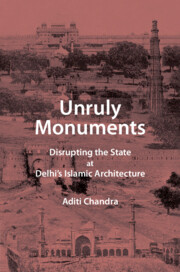Book contents
- Frontmatter
- Dedication
- Contents
- Figures
- Acknowledgments
- Introduction: Unruly Monuments
- 1 Qutb Becomes a Monument: On the Picturesque and Its Discontents
- 2 Museumization Narrates the Lal Qila
- 3 The Traveler’s Archive: Postcards as Partial Souvenirs
- 4 The “Un-exchangeable” Monument: Delhi’s Purana Qila as a Partition Refugee Camp
- 5 Absence of the “Un-exchangeable” Monument: Cinema, Nations, and the “Long Partition”
- Epilogue: Dwelling with Unruliness
- Bibliography
- Index
Introduction: Unruly Monuments
Published online by Cambridge University Press: 04 July 2025
- Frontmatter
- Dedication
- Contents
- Figures
- Acknowledgments
- Introduction: Unruly Monuments
- 1 Qutb Becomes a Monument: On the Picturesque and Its Discontents
- 2 Museumization Narrates the Lal Qila
- 3 The Traveler’s Archive: Postcards as Partial Souvenirs
- 4 The “Un-exchangeable” Monument: Delhi’s Purana Qila as a Partition Refugee Camp
- 5 Absence of the “Un-exchangeable” Monument: Cinema, Nations, and the “Long Partition”
- Epilogue: Dwelling with Unruliness
- Bibliography
- Index
Summary
Prologue
On October 31, 2018, Narendra Modi, the prime minister of India, inaugurated a colossal, 598-foot sculpture of Sardar Vallabh Bhai Patel (1875–1950), a prominent leader of India's struggle for independence and the first home minister of independent India. Called the Statue of Unity, it was meant to signal the strength of a united Indian nation as a global power. Built on an island close to the Narmada River dam, the statue's advertising compared it to the Statue of Liberty, the Spring Temple Buddha, and Christ the Redeemer, among others. The day before the inauguration, however, close to 300 activists, many of them Adivasi farmers, gathered to voice their opposition to this monument, as the sculpture and the proposed development of a “tourism hot spot” around it would displace them from their lands and reduce access to water. Their voices opposing a new national symbol, and their bodies claiming the space of a national monument in order to challenge the state's exclusionary policies, highlight the tenuousness of the public monument as a signifier of an inclusive, united nation.
On January 26, 2021, India's Republic Day, farmers who had been protesting the controversial farm laws, which they saw as removing key state support for agriculture, marched onto and breached the Lal Qila (also known as the Red Fort), a seventeenth-century Mughal fort-palace in Delhi. A group of Sikh protestors climbed onto the fort's ramparts and affixed the Nishan Sahib and other Sikh religious flags to some domes and a flagstaff, physically claiming the Lal Qila with both their bodies and their flags. Happening, as it did, at a monument from which the prime minister gives the Independence Day speech, on a day of national importance and not very far from the venue of the Republic Day parade, where the nation state showcases its military and cultural prowess, this was an act of resistance that was publicly stated and spatially and materially performed.
Information
- Type
- Chapter
- Information
- Unruly MonumentsDisrupting the State at Delhi's Islamic Architecture, pp. 1 - 43Publisher: Cambridge University PressPrint publication year: 2025
